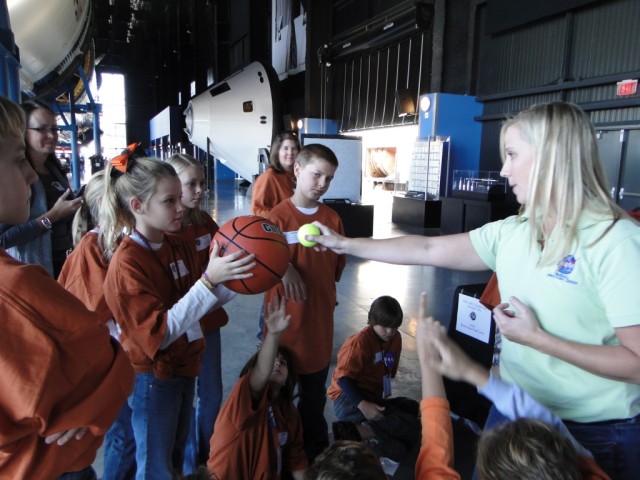Pingpong balls and lava lamps brought the lessons of microgravity down to earth for sixth and seventh grade students who visited educator William Heard's mini-science lab at the U.S. Space & Rocket Center during the third annual Space and Missile Defense Student Day.
"You guys ready to learn some cool stuff'" Heard asked students from Randolph School and Fairview Middle School.
He asked the students if they knew about Daniel Bernoulli, a Swiss mathematician and scientist who lived in the 18th century and who is remembered for his applications of mathematical equations involving the flow of fluids in terms of speed, pressure and potential energy. Heard told them much of modern technology, especially aerodynamics, is based on Bernoulli's formulas.
From the looks on the students' faces, the "stuff" didn't seem so cool anymore.
"This guy was French. He lived in the 1700s. Way back then he was talking about some of the forces acting on nature, some of the things that are the principles of how airplanes actually work," Heard said, as he drove his message into the 21st century. "Bernoulli's Principle explains the lift and drag of airplanes, and the effect of air pressure. It's about microgravity."
Then the "cool stuff" did happen. The students tried their own "lift and drag" experiment with two cups and a pingpong ball. The idea was to blow over the cup containing the ball so that the ball was pushed up and out of the cup, landing in the second cup.
"By blowing over the cup, you are changing the air pressure inside the cup," Heard said. "Blowing across the cup generates a difference in the pressure in the cup and causes the ball to go from one area of high pressure to an area of low pressure."
Heard also used 1960s lava lamp entertainment to further demonstrate the effect microgravity has on fluid. The demonstration was among eight exhibits from government and industry representatives that participated in the Space and Missile Defense Student Day at the U.S. Space & Rocket Center's Davidson Center.
During the event, more than 250 middle school students from Huntsville, Madison, Decatur and Cullman participated in hands-on demonstrations in robotics, unmanned aerial/ground vehicle aircraft, satellite technology, man's quest to rediscover the moon, and other space and missile defense technologies.
The event, which was formerly known as the Education Track during the annual Space and Missile Defense Conference, was developed into its own separate activity to offer students a more in-depth introduction to the use of science, math and engineering in technology career fields. It was sponsored by the Air, Space and Missile Defense Association, the National Defense Industrial Association-Tennessee Valley Chapter and the Air Defense Artillery Association-Redstone Chapter.
While Heard was wowing the middle school students and teachers with Bernoulli and his theories, Capt. Jeff McCoy, Allen Jacobsen and Scott Pollman, of Redstone Arsenal's Raven Product Office, Program Management Office for Unmanned Aircraft Systems, were showing students how they could spy on the variety of student demonstrations with the Raven's infrared camera system.
To get a group of West Point Middle students from Cullman County to think about how the Raven is used by the Army, McCoy asked them a series of questions related to its capabilities -- "When do you think we fly infrared cameras'"; "What's the hottest part of a person's body'" and "What happens when we land it'"
McCoy was impressed with the group's answers, many of them right on target. The students learned that the Raven is designed to collapse and fall apart on landing. They worked together to put a Raven back together.
At another demonstration, NASA educator Julie Clift used a basketball and a tennis ball to talk to students from Holy Spirit Catholic School about the distance between the earth and its moon.
"How many of you think the shuttle can take us to the moon'" she asked, and then explained: "It can't go. So, that's why we're building another rocket."
The students weren't the only ones enjoying the opportunity to participate in hands-on experiments and demonstrations during SMD Student Day. So, too, were the parents and teachers.
"It's great to see the kids interested in engineering and math," said parent Jodi Fador, whose child attends Holy Spirit.
"They've loved the hands-on activities," said Nick White, a math teacher from West Point. "I think this will really help us better teach AMSTI (Alabama Math, Science and Technology Initiative) in the classroom."
Leslie Arnold, a sixth-grade math teacher from Fairview Middle in Cullman County, said her students are seeing their math and science lessons played out in the event's hands-on demonstrations.
"This is a great experience for them," she said. "They are getting to see how math and science applies in real life. It's not just in a book in a classroom."
For some students, SMD Day was also a day of teaching. Phillip Betts and Derek Newcomb of Austin High spent the day talking to middle school students about making robots and then letting them take turns in operating a robot designed and built by the Decatur/Austin Robotics Coalition.
"Technology will let you do lots of things," Newcomb said.






Social Sharing